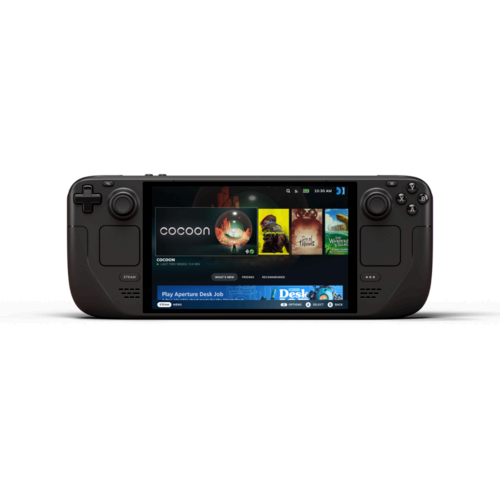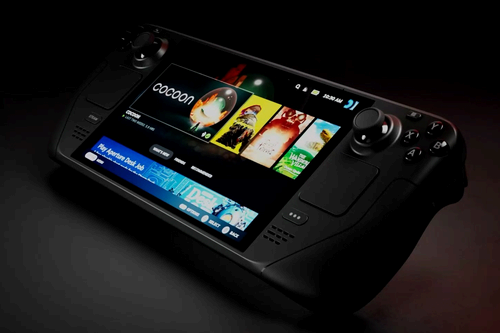While the most significant upgrade in the new Steam Deck is that stunning OLED screen, Valve has managed to pack the revised handheld with a metric ton of improvements. Some of these are just as substantial as the new display. Here are five of the most important ones.
Better Battery Life
The regular Steam Deck comes with a 40mAh battery that can give you about an hour and a half of gaming time at its maximum 15W TDP. That’s far from disappointing and better than what you can get on most other handhelds. For example, I cannot even get one whole hour of battery life when gaming on my ROG Ally at 25W TDP.
The new Steam Deck OLED manages to break the magical two-hour battery life at max TDP thanks to the upgraded 50mAh battery. The new cell is 25% larger than on the Steam Deck LCD, which translates to almost 40% better battery life when gaming at 15W.
This puts the Steam Deck OLED at the front of the handheld gaming PC pack when it comes to battery life. The only other handheld gaming PC that can match the Steam Deck OLED is the humongous AYANEO Kun, which can last for just under two hours when gaming at 25W. This isn’t the Kun’s maximum TDP value, but using higher performance profiles won’t net you noticeable performance improvements either.
The larger battery not only lasts longer but also charges faster. It can go from 20% to 80% in 45 minutes when hooked up to the official charger. This is quite an upgrade, considering that the original Deck needs more than one and a half hours to achieve 80%. The Steam Deck OLED now matches the ROG Ally, the current fast charge champion, which also takes about 40 minutes to fill its cell to 80%.
There’s also a new power brick that comes with a much longer, 8.2ft (2.5m) cable instead of the 4.9ft (1.5m) cable found on the original model. Personally, I’ve always found the original cable too short, so this is yet another welcome upgrade for all Steam Deck OLED owners.
Wi-Fi 6E and Bluetooth 5.3
The biggest pet peeve I and many Redditors have with my Steam Deck is its disappointing wireless performance. I have a 500Mbps internet scheme, but my Deck rarely goes north of 300–350Mbps when downloading games. I’ve left my Deck plugged in with its screen on to download games on multiple occasions, only to return after about an hour and see the download speed drop to a measly 30Mbps or lower. These downloads were far from complete and should have been completed in around half an hour or less.
Even when I handle to get a decent download speed (I’m happy when I see anything higher than 200Mbps), I know it’ll drop to a crawl sooner or later. The wireless performance issues also affected my local game streaming encounter. My encounter with the ROG Ally demonstrated that my Wi-Fi 5 router, which I suspected was the main culprit, was working fine. It’s the original Steam Deck’s wireless chip that was to blame.
The new Deck OLED should put all those issues to rest thanks to its Wi-Fi 6E chip. If the performance of the ROG Ally’s Wi-Fi 6E chip is any indicator, this should improve both the average download speeds and local streaming stability. If the Deck OLED provides similar wireless performance (and there’s no reason it shouldn’t) its Wi-Fi 6E upgrade could be as important as the OLED screen upgrade.
Valve didn’t only upgrade Wi-Fi. The Steam Deck OLED also comes with Bluetooth 5.3, and the handheld now natively supports aptX HD and aptX low-latency Bluetooth codecs. You can now use Bluetooth headphones and earbuds that uphold aptX low latency and finally get a lag-free audio encounter over Bluetooth.
The Steam Deck OLED also has a separate Bluetooth antenna, improving the overall connection quality, especially when using multiple Bluetooth controllers simultaneously. Last but not least, you can wake up the OLED version with any Bluetooth controller, which is very handy when docked.
Double the Maximum Storage
Instead of topping out at 512GB, the Steam Deck OLED includes a 1TB storage option. This is a massive improvement, especially if you find 512GB of SSD storage lacking and aren’t ready to open your Deck and upgrade its SSD.
A Bigger and Better Cooling Fan
Another considerable upgrade found in the Steam Deck OLED is the new cooling fan. The new fan should be quieter due to the enhance in size since it won’t have to ramp up in speed as often and can work at a lower RPM. It’s also more performant, allowing the APU to run cooler than on the Steam Deck LCD.
While my original Steam Deck is relatively quiet most of the time, the fan can get annoying when gaming at the max TDP, especially when charging the Deck at the same time. Personally, the issue isn’t severe enough to be game-breaking, but I reckon Steam Deck owners who often game in bed will find this upgrade almost as important as the new screen.
The OLED Screen Supports HDR and a 90Hz Refresh Rate
Not only does the new screen come with the punchy colors and inky blacks you’d normally associate with OLED, there’s also a higher maximum brightness. While the Steam Deck LCD tops out at 400 nits, the OLED version goes up to 600 nits. It’s also HDR-ready and has a 90Hz refresh rate.
HDR uphold isn’t just a marketing ploy. The maximum HDR brightness is set at 1000 nits, which is plenty for an OLED screen and should make HDR-compliant games look gorgeous on the Deck OLED.
On the flip side, the OLED screen doesn’t uphold variable refresh rate, which is a bummer. Fortunately, you can tweak the refresh rate in 1Hz steps down to 30Hz, and get a tear-free gaming encounter in titles that cannot achieve 90 frames per second.
The screen is slightly bigger, too. The 7.4-inch panel is slightly larger than the 7-inch panel found on the original Steam Deck. It’s not much, but the benefit of a slightly larger screen in the same body is radically slimmer bezels. This makes the Steam Deck OLED look even sleeker than the Steam Deck LCD. I love it!
Aside from these visible improvements, the touch-screen layer is now more responsive thanks to the 180Hz polling rate.
The Rest of the Upgrades Aren’t Too Shabby, Either
The aforementioned upgrades are the most important ones you can find on the new Steam Deck OLED, but they are just the tip of the enhancement iceberg Valve has packed inside its tiny shell. Here are a few other improvements I believe are worth mentioning:
- Better speakers with more bass make games sound fuller than on the Steam Deck LCD.
- You can now use Steam Deck’s built-in microphones with 3.5mm headphones.
- Torque screws that can’t be stripped as easily, along with metal threads, are a godsend for tinkerers.
- Faster, 6400 MT/s memory can give you a few extra frames in some games, but don’t expect miracles.
- Redesigned thumbsticks are grippier than on the OG Steam Deck.
- The new 6nm APU is more efficient than the 7nm chip found in Steam Deck LCD.
- Slimmer screen bezels, black thumbstick domes, and the orange power button make Steam Deck OLED quite a looker.
- The thermal module covering the APU is thicker, decreasing thermals under load.
- More precise trackpads with better haptics.
- Steam Deck OLED is 5% lighter than the Steam Deck LCD.
- The Steam Deck OLED 1TB version also comes with an etched screen and an exclusive, two-part carrying case.

Steam Deck OLED
The Steam Deck OLED is a clear improvement over Valve’s original handheld console, with a larger battery, more storage, faster Wi-Fi, and more. Not to overlook the bigger and better-looking OLED screen that gives the device its name.


